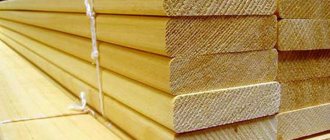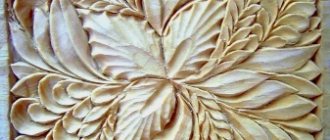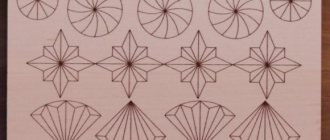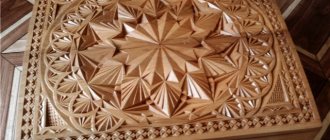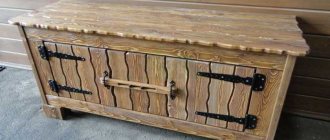Artistic wood carving has developed over centuries. The article discusses types of wood carving - from traditional to the most modern.
From the earliest stages of the development of human civilization, wood has been used to make homes, vehicles, and household items.
Many craftsmen were engaged in wood processing. They tried to decorate the finished product - a new house, a boat, a small item, a children's toy. Artistic wood carving, which initially consisted of applying simple ornaments, developed over centuries. Woodworking skills improved with the advent of new tools and other capabilities.
History of carving
In Russia, with its forest resources, wood was used in all spheres of life. Houses were built from wood, and in a later historical period - temples; furniture and kitchen utensils were made. Boats and ships were made from many types of wood. Tools were partially or completely made of wood.
Wooden sculptures were related to religion and rituals. The oldest object carved from wood is the Shigir idol. This larch sculpture was found in the Urals. The idol is covered with various patterns reflecting the worldview of the people of that time.
In the 16th century, wood carving was a widespread folk craft. It became a real art in the 17th and subsequent centuries. Many types of wood carving were used simultaneously to decorate churches and palaces.
The centers of carving in Russia were the following villages:
- Bogorodskoe;
- Argunovo;
- Abramtsevo, Kudrino and others.
Each of these places developed its own special style, determined by the types of wood, working methods, tools used, and the nature of the ornaments and designs.
In the world, the development of wood carving is also associated with the supply of natural resources.
The most famous products are from countries and regions such as:
- North America - art of Indian tribes;
- Scandinavian countries, Great Britain - reliefs;
- China - Dongyang carving (pronunciation: Don-yang or Dong-yang). High reliefs, round sculpture, incised carvings;
- India and Southeast Asian countries: temple carvings;
- Japan: miniature sculptures of netsuke and okimono, theatrical masks;
- countries of the Islamic world - decoration of mosques;
- Africa - ritual masks and household items made from local wood species (many of them are perceived as exotic in the Northern Hemisphere).
Popular message topics
- Cabbage butterfly
The cabbage butterfly can be found in Asia, North Africa and Europe. Most of all, she chooses habitats in meadows, forest edges and clearings. Large concentrations of cabbage weeds can be observed near railways and country roads. - Euoplocephalus
Euoplocephalus is the oldest lizard that inhabited our planet about seventy million years ago. His remains were found at the beginning of the twentieth century in America. The results of research and excavations confirm the time - India
India is a country of temples. They range in size from tiny structures located in the middle of roads to massive ancient temples carved out of rocks. Some of the temples are famous and decorated with gold, while others are more modest.
Modern carving: classification by type of carving
Important for classification:
- ratio of background and pattern in height;
- shape of pattern elements;
- tools with which work is performed.
Through thread
Characterized by through holes. In appearance it resembles lace. As a rule, it is a solid pattern on a background with fragments removed.
An important role is played by the method of how exactly, with the help of which tool, areas of the background are removed.
Its subspecies
Wood carving
Through holes are created using a jigsaw or saw. Working with a jigsaw is often called wood sawing.
Wood carving
Decorations made using this technique are often found on the facades of houses. This method is used to decorate furniture, shelves and many small household items: boxes, candlesticks, kitchen utensils.
Carved or openwork wood carving
To remove areas of the background, use chisels. Depending on the sampling method, the tree is divided into:
Blind thread
There are no through holes either in the picture or in the background of the product.
At the same time, the height of the background and the pattern relative to each other allows us to classify the types of blind thread as follows:
Relief wood carving
Subtypes: bas-relief and high-relief. From the French terms meaning "low relief" (bas-relief) and "high relief" (haut-relief). Low relief is not much different from engraving.
Bas-relief - the drawing rises above the background by less than 1/2 of its height.
High relief - protrudes above the background by more than 1/2 of the height and looks like a sculpture that is not completely separated from the background.
Relief wood carving by master Kronid Gogolev
Flat thread
Flat wood carving
It is divided into flat-relief (the pattern is recessed into the background) and flat-relief (the pattern protrudes above the background).
Flat-relief wood carving is characterized by a depth of 5 to 20 mm. Varieties:
- with an oval outline;
— with a pillow background;
- with a selected background.
The flat carving differs slightly from the background in height of the pattern.
Contour wood carving
Known as a form of folk art since the 15th century. Consists of lines cut along the contour of the design.
Staple (nail) thread
The pattern consists of peculiar brackets, reminiscent of a fingernail mark.
Bracket thread
To apply the design and relief, use a semicircular chisel. At the first stage, the tool is held at a right angle, then at a sharp angle.
Geometric carving
Older than many other species. Recesses in the form of triangles, squares, semicircles and circles. The technology is not the most complicated. Used to decorate houses and household items (chests, benches, spinning wheels, dishes).
- Triangular notched thread - if you look at such a thread in profile, the notches will be triangular in shape.
- Double-sided notch thread - two faces of the notch meet at an angle of 30-40 degrees.
- Four-sided notch thread - the recesses have the shape of squares and rectangles. The technique is similar to the triangular notch.
- Black varnish carving is close in appearance to wood engraving. The background is covered with black paint or varnish. The image remains light, natural wood color, contrasting with the background. The background color or the color of the picture may predominate (similar to positive and negative in photography). The finished product is coated with colorless varnish.
Volumetric carving (sculptural)
Distributed throughout the world. The creation of three-dimensional objects from wood goes back to ancient times. Wooden sculptures were directly related to religion: idols, images of gods in various cultures, and other objects of worship. In North America - Indian totem poles.
Miniature: Japanese netsuke and okimono. To make netsuke, in addition to polished wood, other materials were used: stone, bone.
Bogorodskaya wood carving
It got its name from the village of Bogorodskoye near Moscow, in the vicinity of the city of Sergiev Posad.
It was born and formed as a separate movement in the 17th-18th centuries.
Bogorodsk toys became famous. The main characters are mainly animals, birds, and fairy-tale characters. These sculptures are made using a special technique, using a “Bogorodsk knife” - short, with a beveled blade. Material - soft wood, usually linden, less often - alder, aspen. Carving was historically carried out “on the fly,” that is, without preliminary sketches, which is how the term “fly carving” appeared.
Toys come in the form of a separate sculpture or in the form of a sculptural multi-figure composition. The compositions are:
a) static (example: “Mice bury a cat” from the Russian Museum)
b) moving.
The moving toy “Blacksmiths” became a symbol of Bogorodsk craft: a man and a bear take turns hitting an anvil.
Bogorodsk toys made at the beginning of the 19th century have been preserved in museums.
House carving
It stands out as a separate direction, despite the fact that it combines all three of the above types.
In Russia, historically, houses were built mainly from wood. They were decorated with carved elements: shutters, cornices, figured pillars on the porch. Since the 19th century, the most common technique in which decorative elements of houses were made was slotted carving, through or sawn.
House carving elements:
valances - carved boards hanging from the eaves of houses;
friezes - located on the gables of houses or under the eaves;
piers - located on the pediment and corners of the house;
“towels” are small-sized openwork boards that hang from the roof ridges.
Chainsaw carving
Used for large sculptures and sculptural compositions. Their height is comparable to the height of a person and more. This technology is used to make landscape sculptures, architectural details, and pieces of furniture.
Chainsaw carving
Chainsaws of different sizes and capacities are used. They work with wood of different densities and many types of wood. Main: larch, maple, elm, oak.
In order not to confuse chainsaw carving with other types of sculpture creation, the term “carving” is often used.
The direction is relatively new, but has managed to establish itself as a way to create real works of art.
Which tool is better?
There is a special tool for the Tatyanka style with parameters designed to work with plastic wood. If your instrument is homemade or factory-made, it may be of little use due to mismatches in size and other parameters.
Working with unsuitable types of cutters greatly complicates the process of learning to carve and reduces its effectiveness. The first simple educational ornaments are made using the most common student set, consisting of chisels No. 6 and No. 17 (semicircular of medium diameter) and a jamb knife. The blade of semicircular chisels in cross section looks like part of a circle. If you place such a tool with its end on the board and then rotate it around its axis, the blade closes the circle, cutting through the wood.
An important quality of a chisel that allows you to make deep cuts is maneuverability. A joint knife is one of the main tools. The name comes from the shape of the blade with an oblique cut. Its size is usually suitable for medium-sized hands.
Classification by territorial basis
Argunov wood carving
The name comes from the village of Argunovo (Vladimir province, Pokrovsky district), where skilled carpenters lived and worked. In the 19th century, their products became widespread and famous. In Dahl's dictionary there is the word “argun”, which is explained as “Vladimir carpenter”.
Carved furniture, church iconostases, decor of wooden huts and palaces - Argunov carvings are found everywhere. Its characteristics: a wide variety of designs using pagan elements. A harmonious combination of ancient Russian images and characters of classical European art.
Nizhny Novgorod wood carving
Another name is ship. Initially it was used to decorate Volga ships. Then they began to decorate wooden houses: platbands, frontal boards, blades. Nizhny Novgorod blind carving is distinguished by a “blind” (non-cut) background. The main tool used is a rounded chisel. The height of the drawing is almost on the same level as the board.
The treated board was covered with drying oil in several layers. Coloring occurs, but is rare.
Kudrinskaya wood carving
Comes from the village of Kudrino near Moscow. Refers to flat-relief carving - medium in height between contour and relief. The background of Kudrinskaya carving can be pillow-shaped or optional.
Typical floral patterns include garlands, branches, fruits, flowers, curly leaves. Stylized elements: birds, animals. Scenes from fairy tales.
Scandinavian wood carving
Drawing: complex wavy lines and patterns, animal figures, plant motifs, less often - a geometric pattern. Historical scenes. Blind relief carving is mainly used.
What is the difficulty of artistic woodworking?
Carving has always been complex and somewhat dangerous for the master. Work involves interaction with sharp tools, machines and chemicals.
It follows that for greater safety you need to adhere to the following rules:
- The workplace must be clean and lit.
- All auxiliary items, including the table, must be resistant to physical impact.
- Tools should be placed in plain sight and put away when not needed. Electrical appliances should only be plugged into a working outlet.
- It is necessary to have fire protection and a first aid kit near the workplace. During work, you need to use protective equipment, for example, glasses, gloves, a respirator.
The teacher of carving courses must supervise the activities of the novice specialist.

